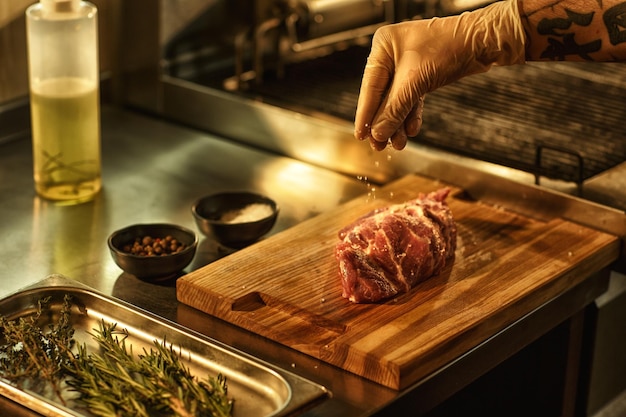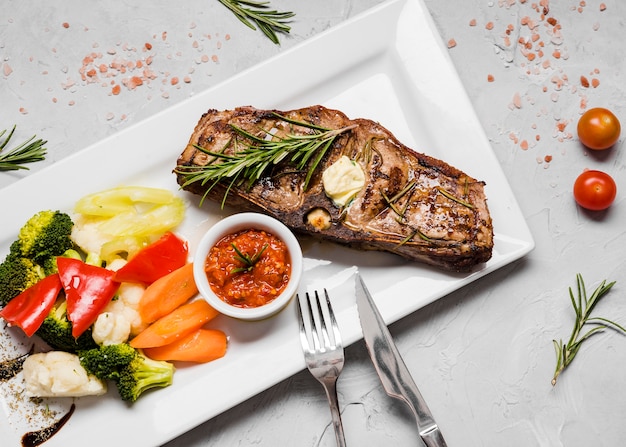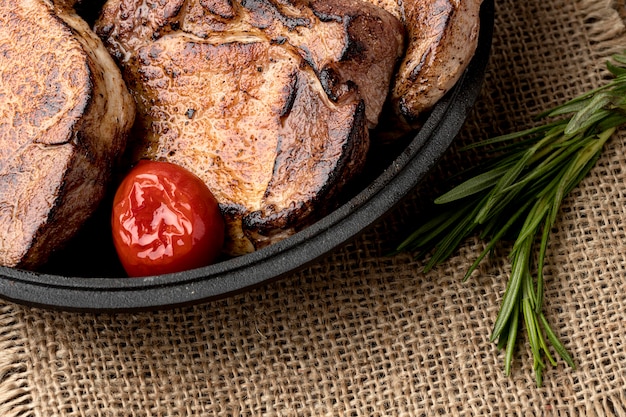Let's be honest, the thought of cooking a beef tenderloin can be a little daunting. It's that special cut of meat you see on fancy menus, and it's often associated with those intimidating high-end steak houses. But guess what? It's not as complicated as it seems. With the right approach, you can easily transform your kitchen into a culinary haven, serving up a tenderloin that'll impress even the most discerning foodie.
Over the years, I've had my fair share of triumphs (and let's be honest, a few mishaps) when it comes to roasting this prized cut. But trust me, the journey of mastering this meat is worth every minute, every mistake, and every delicious bite.
Part 1: The Basics of Beef Tenderloin

Let's get to know our star ingredient: the beef tenderloin. It's not just any piece of meat – it's the king of the cow.
The Cut
The tenderloin is a long, narrow muscle that stretches along the underside of the cow's backbone. It's considered the "filet" – a fancy word for the most tender and flavorful part of the beef. The reason for its luxurious texture? It's not used for much movement, so the muscle remains unbelievably soft.
choosing the right cut
Now, before you even start thinking about cooking methods, let's pick a winner. When you're at the butcher counter, look for a tenderloin with good marbling – those white fat streaks running through the meat. This is like the secret ingredient for juiciness and a delicious, rich flavor. Don't be afraid to chat with the butcher – they're experts and can help you pick the perfect cut for your needs.
Part 2: Preparing the Tenderloin

It's time to get our hands dirty! The prep stage is key to a beautiful, flavorful roast.
Trimming
The first order of business is trimming the tenderloin. We need to get rid of any excess fat and that tough, silvery skin called "silver skin." Now, don't worry, this doesn't require a meat-carving degree. Simply use a sharp knife and cut along the silver skin to detach it from the meat. A handy tip I learned: grab the silver skin with a paper towel for a better grip – it'll prevent it from slipping around.
Seasoning
Alright, this is where things get fun. You can go with a classic salt and pepper seasoning – it's always a winner. But feel free to experiment. I love adding a sprinkle of garlic powder, a touch of paprika, and a dash of herbs like rosemary or thyme. Just be generous with your seasoning – the meat will absorb all that flavor as it cooks, creating a delicious symphony of tastes.
Part 3: Cooking Methods

We're ready to cook! But first, let's choose our method. There are a few ways to cook a tenderloin, each with its unique charm.
Roasting
Roasting is like a warm hug for the tenderloin. It gives you an even, gentle cook, resulting in a juicy and tender roast. I find this method perfect for a more formal dinner or a special occasion. Imagine a beautifully golden-brown roast, resting majestically on a platter, ready to be sliced and enjoyed.
Pan-Searing
Pan-searing is for those who crave a little more intensity. It's perfect for smaller sections of the tenderloin, creating a crispy, caramelized crust on the outside while locking in the juiciness inside. I often use this method for weeknight meals – it's quick, impressive, and bursting with flavor.
Grilling
Grilling is a celebration of summer. It gives the tenderloin a smoky, chargrilled flavor that's perfect for outdoor gatherings and barbecues. Imagine the sizzle of the meat on the hot grill, the aroma filling the air – it's a truly satisfying experience.
Part 4: The Secret to Perfectly Cooked Beef Tenderloin
Now for the real magic – cooking the tenderloin to perfection. This is where a little precision goes a long way.
Temperature Chart
| Doneness | internal temperature (°F) | Internal Temperature (°C) |
|---|---|---|
| Rare | 125-130 | 52-54 |
| Medium-Rare | 130-135 | 54-57 |
| Medium | 140-145 | 60-63 |
| Medium-Well | 150-155 | 65-68 |
| Well Done | 160 | 71 |
Using a meat thermometer
This little gadget is your new best friend. It takes all the guesswork out of cooking and ensures you get that perfect level of doneness. Insert the thermometer into the thickest part of the meat to get an accurate reading. Don't forget to wash it thoroughly after use!
Part 5: Resting the Roast
Once your tenderloin is cooked, it's time to give it a well-deserved rest. Think of it as a spa treatment for your meat.
Tenting with Foil
Cover the roast with a sheet of foil and let it rest in a warm place for at least 10-15 minutes. This allows the juices to redistribute evenly throughout the meat, making it even more tender and flavorful. Imagine those juices seeping back into the meat, creating a symphony of flavors.
Part 6: Carving the Tenderloin
It's time to unveil the beauty of your cooked tenderloin!
Using a Sharp Knife
Grab your sharpest knife. A thin-bladed knife will slice through the meat effortlessly, preventing any crushing or tearing. This is your tool to unleash the beauty within.
Slicing Against the Grain
Here's a secret to ultimate tenderness: slice the tenderloin against the grain. This means cutting perpendicular to the muscle fibers. It ensures each bite is melt-in-your-mouth tender and prevents that chewy, tough texture.
Part 7: Serving and Enjoying
Now it's time to savor the fruits of your labor!
Choosing Sides
The beauty of tenderloin is its versatility. It pairs beautifully with a wide range of sides, from classic mashed potatoes and roasted vegetables to more adventurous options like a salad with a vinaigrette dressing.
Serving Suggestions
Serve the tenderloin sliced, with a side of your favourite sauce. My go-to is a simple gravy, but you can also explore a red wine sauce or a creamy mushroom sauce. The possibilities are endless!
Part 8: Storing Leftovers
Let's be honest, leftovers are a rare sight after a delicious tenderloin feast. But if you happen to have any, store them in an airtight container in the refrigerator for up to 3 days.
Reheating
The best way to reheat tenderloin is in the oven. Preheat it to 350°F (175°C) and heat the roast until it's heated through. It's like giving it a second chance to shine!
Part 9: FAQs
What are some good substitutes for beef tenderloin?
If you're looking for a more budget-friendly option, try a sirloin roast or a chuck roast. These cuts are still tender and flavorful, but they're a bit easier on the wallet.
Can I freeze beef tenderloin?
Yes, you can freeze beef tenderloin. Wrap it tightly in plastic wrap and then foil and freeze for up to 3 months.
What are some good wines to pair with beef tenderloin?
A good red wine like Cabernet Sauvignon, Merlot, or Pinot Noir will beautifully complement the rich flavor of the beef. You could also try a lighter red like Beaujolais or a white wine like Chardonnay.
How do I tell if the beef tenderloin is done?
Use a meat thermometer to check the internal temperature. If you don’t have a thermometer, you can test the doneness by pressing on the meat with your finger. A rare roast will be very soft, a medium-rare roast will be slightly springy, and a medium roast will be firm.
What are some tips for making a tenderloin more flavorful?
You can add extra flavor by marinating the tenderloin in advance. Try a simple marinade of olive oil, garlic, herbs, and salt and pepper. Or, you could try a more adventurous marinade with citrus juice, soy sauce, or spices.
I hope this guide has given you the confidence to tackle a beef tenderloin with ease. Remember, the key to a perfect roast is to use high-quality ingredients, season it generously, cook it to the right temperature, and let it rest before carving. With a little practice, you'll be a tenderloin expert in no time!
Everyone is watching

How to Cook Frozen Lobster Tails Perfectly: A Step-by-Step Guide
RecipesLobster. Just the word conjures up images of lavish meals, special occasions, and a taste of luxury. But let's...

Pigs in a Blanket Cooking Time: How Long to Bake for Perfect Results
RecipesAh, pigs in a blanket. Just the name conjures up images of those delightful little parcels of crispy pastry en...

Pork Fillet Cooking Time: How Long to Cook It Perfectly
RecipesPork fillet, or tenderloin as it's sometimes called, is a real favourite in our house. It's so versatile, and...

The Ultimate Guide to Cooking Delicious Frankfurters
RecipesLet's face it, we all love a good frankfurter. It's a classic, simple, and always satisfying. But let's be rea...

Wolf Meat Recipes: A Guide to Cooking Wild Game
RecipesLet's be honest, you don't see wolf meat at your local butcher shop every day. It's a bit of a wild card, but ...
